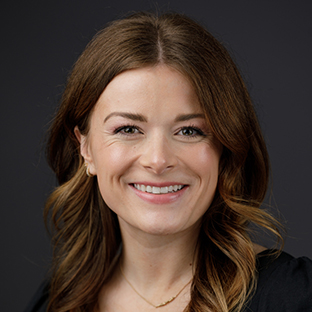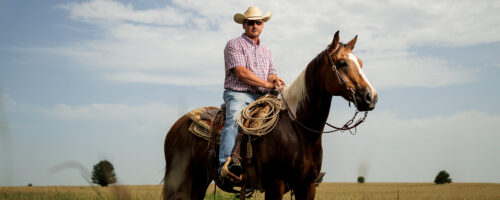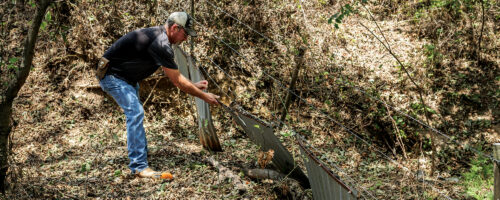Embrace Change: Cultivating Pasture Diversity
Transitioning your ranchland from a bermudagrass monoculture to more diverse native species is not a neat process. It involves embracing and managing the messiness that comes with change.
For ranchers focused on profit, animal health, soil health and wildlife, a shift from introduced grasses to more diverse native plants is essential to achieving these goals.
Mike Porter, senior regenerative ranching advisor at Noble Research Institute, explains that by working with nature rather than against it, ranchers can create more sustainable and resilient pasture systems.
The hallmark of good ranch management commonly has been perceived as well-manicured, monoculture pastures. These pastures, often dominated by bermudagrass, are kept looking pristine through regular fertilization, weed control and haying, mowing or grazing. However, this conventional approach comes with high costs and significant negative environmental impacts.
“Many ranchers now recognizethe limitations of this system andthe need for a different approach,” Porter explains.
4 Strategies to Enhance Pasture Diversity:
- Assessing and planning: Start by assessing your current pasture conditions. Identify the existing plant species and soil health. Set clear goals for what you want to achieve and develop a plan for how to get there.
- Encouraging native species: Native plants are well-adapted to local conditions and are more likely to thrive. Consider managing for native grasses and other forbs in your pastures.
- Grazing adaptively: Stocking appropriately and moving livestock through different paddocks while leaving adequate residue and providing adequate rest allows plants time to recover and grow. This approach also mimics natural grazing patterns, promoting a healthier ecosystem.
- Planting cover crops: In simple ecosystems such as introduced pastures or commercial crops, cover crops can protect the soil during off-seasons and provide additional forage.
WHY PASTURE DIVERSITY IS ESSENTIAL
“People looking to make this change want to improve their profit by reducing inputs, to improve their soils and ecosystem processes and to enhance wildlife habitat,” Porter says.
Bermudagrass monocultures require many inputs, such as fertilizers and herbicides, which are expensive and can degrade ecosystem processes. Switching to native grasses helps reduce these needs.
Jim Johnson, senior regenerative ranching advisor at Noble, also emphasizes cost savings from less reliance on synthetic inputs as another reason to make the transition.
“There are significant cost savings from reduced input use. Healthier livestock need less veterinary intervention due to a more diverse diet,” Johnson says.
Native plants, with their deep root systems, improve soil structure and drought resilience. They also support a more robust wildlife habitat, boosting biodiversity.
“We’re trying to increase diversity, and we’re trying to reduce the need for inputs. The more diversity we have, the better the nutrient cycle works,” Porter says. “Ranchers commonly destroy their profit by buying too many inputs: fertilizer, weed spray, hay, tillage, mowing, and those types of things.”
Johnson and Porter agree the goal usually isn’t to eliminate bermudagrass entirely but to increase plant diversity, creating a more resilient and sustainable pasture system.

THE RIGHT APPROACH FOR YOU
“There’s no recipe, there’s no prescription,” Porter says. “You have to look at what you’ve got, where you want to go, and then figure out the most likely way to get there.”
Different methods can achieve diversity, but the choice ultimately depends on your goals, resources and long-term vision for your ranch. Porter usually encourages managing the natural succession of pasture. Succession is the natural progressive process of change from simpler soils and plant communities to more complex and usually more productive soils and communities.
“Plant communities are dynamic.They do not stay the same. They’re always changing,” Porter says. “What we do with the natural-succession approach is we manage that change.”
The natural-succession approach allows plant communities to change gradually without heavy inputs. This approach involves reducing most disturbances (e.g., fertilization, pesticides, mowing, haying and overgrazing), adjusting stocking rates and carefully managing grazing and recovery to encourage the growth of diverseplant species.
“This approach can be more practical for ranchers looking to reduce costs and negative environmental impacts than attempted total elimination of introduced pasture through tillage and pesticides and then attempted total replacement through planting,” Porter says.
Ranchers may be familiar with a high-input approach to achieving diversity. While this approach can be practical for some, it probably is not practical for many, as it requires significant investment and major disturbances.
Brandon Baker, wildlife biologist at the Oklahoma Department of Wildlife Conservation, successfully used the high-input approach to reestablish areas of bermudagrass pasture to native grasses and forbs, in order to focus on wildlife habitat improvement.
“We’re seeing turkey and quail specifically. Before there was no quail present at all because it was a monoculture bermudagrass,” Baker says. “The native grass is also better for soil health. The root structure of native grasses establishes a lot deeper in the soil than bermudagrass.”
The natural-succession approach is ideal for those looking to embrace regenerative practices and work closely with natural processes. Ultimately, your chosen path should align with your objectives and values for sustainable ranch management.

A MINDSET FOR SUCCESS
Transitioning from traditional pasture management to a more diverse and regenerative system requires more than just a change in management; it demands patience and a significant mindset shift.
“Ranchers need to understand if they’re going down this path, it looks messy to those used to a manicured landscape,” says Porter.
The transition to a diverse pasture system involves allowing native plants to grow, which usually appears untidy to those used to a manicured landscape, but such growth is crucial for long-term soil health and ecosystem balance.
Porter also points out that traditional overstocking practices aimed at maximizing short-term beef production are counterproductive in the long run.
“It takes grass to grow grass. The more leaves you leave on a plant, the more sunlight it captures and the more roots it maintains, so the more it can grow,” he says.
Understanding and implementing proper grazing management — grazing only the top parts of plants and allowing sufficient recovery time — is vital for maintaining healthy pastures.
“The most profitable space for most people or most years is when they’re right below carrying capacity,” Porter says. “Carrying capacity is the number of animals that the land can support for the period of time you’re grazing, without hurting the animals or landscape.”
Ranchers can successfully navigate this transition toward more diverse forages through careful planning, monitoring and adaptability.
“Be patient. Have realistic goals, and educate yourself ahead of time on what’s realistic,” Johnson says.

EMBRACING THE PROCESS
Embracing diversity and regenerative practices means playing the long game. It’s about working with nature, not against it.
“There’s no one way to do it. It depends on the situational context and how the land reacts. It boils down to respecting and encouraging diversity, stocking appropriately below carrying capacity, and managing grazing and recovery,” Porter says.
In the end, transitioning to diverse pastures isn’t just about swapping bermudagrass for native grasses. It’s about building a resilient, productive and sustainable ranching system that benefits the soil, livestock, wildlife and your bottom line.
Considerations for Managing Natural Succession:
- Stop most spraying, fertilizing, mowing, haying and over-grazing: Stop spraying weeds and using synthetic fertilizers. These disturbances maintain the competitive edge of bermudagrass over natives.
- Implement rest periods:Allow your pastures adequate time to recover between grazing periods.
- Use prescribed fire: Fire is a natural ecological process that can facilitate natural succession.
- Manage grazing well: Practice top grazing, where you graze only the top parts of the plants to help them recover faster and keep roots healthy.



Comment